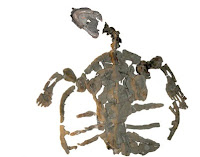Turtles
have a fairly good fossil record, as would be expected for animals
with bony shells inhabiting aquatic and marine habitats, but the
origins of the group remain poorly understood. Molecular studies have
suggested that they are members of the Diapsid Clade, which also
includes Snakes, Lizards, Dinosaurs (including Birds) and Crocodiles,
and probably closely related to the Archosaurs (Dinosaurs and
Crocodiles), but anatomically they are very different to any other
Tetrapod group, and the absence of any skull openings has led to the
suggestion that they branched out from the other Amniotes
(Vertebrates capable of laying eggs on dry land) very early in the
history of the group, possibly even before the Synapsids (the group
that includes the modern Mammals).
To
date only two stem-group Turtles (animals on the way to becoming
Turtles, and more closely related to Turtles than to any other group)
have been described. The 260 million-year-old Eunotosaurus
from South Africa is a Lizard-like animal, which has broad trunk ribs
with a 'T'-shaped cross section, which form a protective case around
the internal organs. The 220 million-year-old Odontochelys
from China is much more Turtle-like, with a developed plastron (lower
shell portion) and a beaked mouth, though it still retains side teeth
and its dorsal surface is protected by flattened ribs rather than a
carapace. The oldest known true Turtles with fused plastrons and
carapaces are 216 million-year-old and come from Thailand and
Germany,
In
a paper published in the journal Nature on 20 July 2015, Rainer Schoch of the Staatliches Museum für Naturkunde Stuttgart and
Hans-Dieter Sues of the Department of Paleobiology at the Nationa lMuseum of Natural History describe a new stem-group Turtle from the
Middle Triassic Erfort Formation at Schumann Quarry in
Baden-Würtremburg,
Germany.
The first described specimen of Pappochellys rosinae. Rainer Schoch/Staatliches Museum für Naturkunde Stuttgart.
The
new species is named Pappochelys rosinae, where 'Pappochelys'
means 'Grandfather Turtle' in Greek and 'rosinae' honours Isabell Rosin, who prepared the fossils from which the species is described.
The species is described from two specimens, an articulated partial
skeleton lacking a skull and a disarticulated skeleton with a partial
skull, though reference is made to a further 18 specimens.
Skeletal elements from which the skull of Pappochelys rosinae was reconstructed. Schoch & Sues (2015).
Pappochelys
rosinae was a small, flattened, elongate animal about 20 cm in
length. It lacks a true plastron (ventral shell) but has a number of
large, paired bony gastrula (bony plates produced within the dermal
layer) covering its ventral surface, structures which had been
predicted for ancestral Turtle-like animals, but not previously seen.
As in Eunotosaurus and Odontochelys the dorsal surface
is protected by thick, flattened ribs with a 'T'-shaped cross
section. Pappochelys lacks a beak, retaining teeth in the
front and sides of its mouth and (importantly) retains two pairs of
skull openings, features which clearly identify it as a Diapsid,
strongly supporting the genetic evidence for a Diapsid origin for
Turtles.
Reconstruction of Pappochelys rosinae, showing the position of the skeletal elements that would become the shell in later Turtles. Rainer Schoch/Staatliches Museum für Naturkunde Stuttgart.
See
also...
 Desmatochelys padillai: A Protostegid Turtle from the Early Cretaceous of Colombia. The
Protostegid Turtles were a group of Turtles known from the Cretaceous
that are thought to have been members of the Chelonioidea, the group
that includes the two living Marine Turtle groups, the Chelonidoidea
(Sea Turtles) and Dermochelyidae (Leatherback...
Desmatochelys padillai: A Protostegid Turtle from the Early Cretaceous of Colombia. The
Protostegid Turtles were a group of Turtles known from the Cretaceous
that are thought to have been members of the Chelonioidea, the group
that includes the two living Marine Turtle groups, the Chelonidoidea
(Sea Turtles) and Dermochelyidae (Leatherback... A fossil Turtle from the Early Cretaceous Jehol Biota. One of the first Vertebrate fossils described from the Jehol Biota was Manchurochelys manchoukuoensis,
a Eucryptodire Turtle from the Yixian Formation of Liaoning Province,
China. The first specimen of this...
A fossil Turtle from the Early Cretaceous Jehol Biota. One of the first Vertebrate fossils described from the Jehol Biota was Manchurochelys manchoukuoensis,
a Eucryptodire Turtle from the Yixian Formation of Liaoning Province,
China. The first specimen of this... A new species of Turtle from the Late Cretaceous of Morocco. Turtles are aquatic reptiles with a shell that encases their body, and
into which the head and limbs can be retracted at least partially. They
have a fossil record that dates back to the Late Triassic, about 220
million...
A new species of Turtle from the Late Cretaceous of Morocco. Turtles are aquatic reptiles with a shell that encases their body, and
into which the head and limbs can be retracted at least partially. They
have a fossil record that dates back to the Late Triassic, about 220
million...
Follow
Sciency Thoughts on Facebook.



